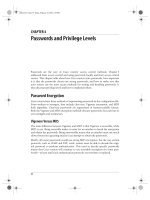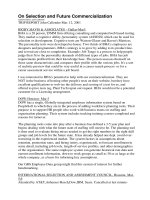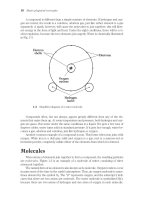MODERN AND CONTEMPORARY SCULPTURE pdf
Bạn đang xem bản rút gọn của tài liệu. Xem và tải ngay bản đầy đủ của tài liệu tại đây (336.29 KB, 28 trang )
MODERN AND CONTEMPORARY
SCULPTURE
WOLSELEY FINE ARTS
MODERN AND CONTEMPORARY
SCULPTURE
All items are for sale
WOLSELEY FINE ARTS
Needham Road, Westbourne Grove, London
Te l : + () , Fax + ()
E mail: info@wolseleyfinearts.com Web site: www.wolseleyfinearts.com
The catalogue was prepared by Rupert Otten and Hanneke van der Werf of Wolseley Fine Arts
Photographs by Rodney Todd-White, London
Design by Helen Swansbourne, London
Printed by Disc to Print, London
ISBN
Catalogue Number
All enquiries regarding the items in this catalogue should be addressed to
Wolseley Fine Arts Ltd
Needham Road
London
Te l + ()
E mail: info@wolseleyfinearts.com
33
MODERN SCULPTURE
Michael Ayrton
–, British
Ayrton was a sculptor, painter, printmaker and
writer. He started his career as a painter in the
Neo-Romantic tradition. His contributions to
‘The Spectator’ during - were important in
the acceptance of Neo Romanticism. From
Ayrton traveled widely in Italy.
He began to sculpt in bronze in the early
s receiving some advice from Henry Moore
and visited Cumae in – and Greece in
, turning to Greek myth as his principal
source of inspiration, particularly the legends of
Daedelus and Icarus, the Minotaur and the
image of the maze. His powerful style sought to
reinterpret mythological ideas in terms of the
figure.
His reinvention of the achievements and
techniques of antiquity and his experiments
using Perspex in reflective sculpture place him
amongst the most original sculptors of his time.
Web
Bronze steel and threads, figure x . x cm
plus stand of . cm, overall . cm
Signed and numbered /
Literature: Peter Canon-Brookes, Michael Ayrton
An Illustrated Commentary,
Birmingham Museums and Art Gallery
, page no (illustrated)
4
Reg Butler
–
Butler was a sculptor and teacher who trained as
an architect. After an initial career in
architecture he started working as a sculptor in
, after working as a blacksmith during
WWII, joining Henry Moore as an assistant.
His first one man exhibition was held at the
Hanover Gallery, London, in . The following
year he preceded Kenneth Armitage in receiving
The Gregory Fellowship awarded by Leeds
University. It was during his three years in Leeds
that he fully developed his sculptural style. He
abandoned his past methods of welding in iron
as he felt that he was being overwhelmed by the
material itself. He turned instead to modeling in
clay or plaster and casting the models in a thin
lightweight bronze, of which the work in this
exhibition is a good example.
In , Butler (alongside Lynn Chadwick)
was among the eight sculptors chosen to
represent Britain at the Venice Biennale, where
his work was highly acclaimed.
Woman on Boat
Bronze
x x . cm, ¾ x x ½ ins
Signed with monogram and numbered and
dated /
Provenance: Curt Valentin Gallery, New York,
February
The Estate of Vera G List
4
55
Estella Campavias
–, British
Estella Campavias was of Spanish extraction and
was brought up in Turkey. She began her career
in as a ceramicist, aiming to produce works
of art rather than craft. After a period of
reflection and experimentation she turned to
sculpture.
Her work is figurative with a strong tendency
towards abstraction. The forms are flowing and
smooth, an expression that shows us the inner
character of the human or animal form depicted
rather than the details of the exterior.
Estella received no formal art training which
gives the work a unique and intuitive character.
Head c
Bronze
x x cm
Stamped with the estate stamp and numbered
from the edition of
Cast by Morris Singer
Reclining Figure c
Bronze
x x cm
Stamped with the estate stamp and numbered
from the edition of
Cast by Morris Singer Illustrated
La Joie de Vivre
Bronze, x x cm
Signed with initials and numbered from the
edition of of which only about cast
Cast by T Schroeder, Germany for
Sicommerce AG, Zurich
6
Frank Dobson
–, British
Dobson was a sculptor, draughtsman and
painter. His first sculptures were very stylised. In
he was selected by Wyndham Lewis as the
only sculptor of the ‘Group X’ exhibition. His
post WW carvings are very angular and
Vorticist in style, reminiscent of Gaudier-
Brzeska and Epstein. From the mid twenties he
concentrated mainly on the female nude,
influenced by French sculptor Aristide Maillol.
Kneeling Torso
Bronze, height ¾ ins
Signed Dobson in base and numbered from the
edition of + a/p
One cast was made during the artist’s lifetime and
the rest of the edition and the artist proofs were
cast from the original plaster by Morris Singer in
with the permission of the Dobson estate.
Literature: Neville Jason and Lisa Thompson-
Pharoah, The Sculpture of Frank
Dobson, page number
Kneeling Torso
Plaster, height ¾ ins
Signed Dobson in base Illustrated
The original plaster created by Dobson from
which the casts above were taken.
Literature: Neville Jason and Lisa Thompson-
Pharoah, The Sculpture of Frank
Dobson, page number
6
77
Henri Gaudier-Brzeska
–,French
Gaudier began sculpting in Paris in ,
inspired by Rodin, rather than by the avant-
garde artists of his own generation. When he
moved to London in his knowledge of
contemporary developments in sculpture was
slight. After a meeting with Epstein, Gaudier
started to pursue a more experimental direction.
The work in this exhibition was conceived
shortly after meeting Epstein and already shows
this influence.
Head of a Young Man
Composite cast stone
x . x cm plus base
One of stone casts made by Fiorini from a
mould taken from the original sandstone carving
c.. Three casts are recorded as being in public
museums and a further two at Kettle’s Yard,
Cambridge. The rest are in private collections.
Provenance: Private Collection, London
Literature: Evelyn Silber & David Finn, Gaudier
Brzeska, Life and Art no , illustrated
plate
7
88
Eric Gill
–, British
Eric Gill was a prolific artist in many disciplines
but wanted to be remembered on his grave as a
stone carver. The strength of his work lies in the
use of the direct carving technique. In he
carved his first sculpture and unknowingly re-
instated the direct carving technique by carving
what he had in his head straight into the stone.
At this time sculptors would usually model in
clay, cast in plaster and use this model to let a
craftsman either carve it or cast it in bronze. Gill
however carved directly into the stone and was
most likely the first sculptor to do so since the
Middle Ages. Occasionally he modelled in
plasticine and had casts made either in plaster or
bronze.
Madonna and Child I /
Painted plaster, height . cm
Signed with initials and numbered on base
Literature: Judith Collins, Eric Gill – The Sculpture,
London page number
Here Judith Collins describes how an
edition of plaster casts were made from
an original plasticine model. It is not
clear how many plaster casts were
made, each of which was individually
painted. The plasticine model was also
used to make an edition of in bronze.
99
Barbara Hepworth
– , British
Hepworth discovered her passion for art as a
young child and, in , entered Leeds School
of Art. Two years later she was admitted to the
Royal College of Art in London, from which she
graduated in . While on a postgraduate
fellowship in Italy, Hepworth worked with
master stone carvers and met the British
sculptor John Skeaping, whom she later
married. Back in London, Hepworth was one of
a small group of pioneering sculptors
committed to exploring abstraction. She had her
first solo exhibition in and, by the early
s, had developed her mature style: a
sensuous kind of organic abstraction, sometimes
incorporating strings, wires, coloured paint, or
holes piercing the sculpted form.
Three Forms (Extra Eye)
Polished bronze
Height . cm, ins excluding stone base
Signed and numbered /
Exhibited: Marlborough Fine Arts, Barbara
Hepworth Recent Work February – March, ,
number
Provenance: Marlborough Fine Arts purchased by
Avraham Havillo, Israel, from whom
acquired by Wolseley Fine Arts
Literature: Alan Bowness, The Complete
Sculpture of Barbara Hepworth -
,London number ,
illustrated page
10
David Jones
–, British
David Jones trained at the Camberwell School of Art and following
the st World War, the Westminster School. In he met Eric Gill
at Ditchling, where he was introduced to wood engraving.
Jones’s early engravings such as Family before Crucifix are
reminiscent of Gill’s medieval style but by Jones had found his
voice as an engraver and the two blocks for the humorous polemic
book Libellus Lapidum containing verses by Douglas Pepler are
highly original works incorporating Art Deco ideas. The works,
although conceived in two dimensions, show a sound grasp of
spatial awareness and the heavily carved sections of the Libellus
Lapidum blocks are very sculptural in form.
(i)Family before Crucifix and (ii) Man in Pub
Boxwood partly gessoed, . x . cm
Used in The Game . Later cut into two blocks with Family before
Crucifix used in St Thomas Aquinas Calendar both published by
St. Dominic’s Press
Literature: Douglas Cleverdon, The Engravings of David Jones, Clover
Hill Editions Reference E
View of Stairs
Boxwood partly gessoed, . x .cm plus stand
Used in Libellus Lapidum, St Dominic’s Press
Literature: Douglas Cleverdon, The Engravings of David Jones, Clover
Hill Editions Reference E
Expulsion of the Money Changers
Boxwood partly gessoed, . x. cm
Used in Libellus Lapidum, St. Dominic’s Press
Literature: Douglas Cleverdon, The Engravings of David Jones, Clover
Hill Editions Reference E
1010
1111
Giacomo Manzù
–, Italian
Manzù’s oeuvre is characterised by recurring
themes like the young girl on a chair, the
cardinals, mother and child and the ice skater. In
all sculptures he made of skaters the figure
depicted is female, wearing a short skirted dress,
standing still after or before skating. Although
her feet look as if she is wearing skates, these
have actually been omitted in the sculpture.
Models for the skaters were Inge Schabel, dancer
at the Salzburg Opera, and her sister Sonia.
Pattinatrice (Ice Skater) c.
Bronze
Height . cm
Signed and stamped with the foundry mark
“Manzù Fonderie Maf Milano” on the base
The work is recorded in the Manzù archive
1212
John Milne
–, British
Milne’s earliest sculptures were modeled in
terracotta, using the pottery kiln at Salford Royal
Technical College, were he studied art. He spent
time in Paris, studying at the Académie de la
Grande Chaumière where Zadkine was one of
the teachers. Milne however was more inspired
by artists like Dobson, Maillol and Brancusi.
Milne was one of the most interesting
sculptors associated with St Ives and Barbara
Hepworth, for whom he was an assistant for
some years, and the English Post War avant
garde movement. His work of the s owed
much to the St Ives milieu in which he lived but
later Milne was influenced by the landscape and
architecture of Greece, Persia and North Africa.
As a result his mature work has a more
international flavour.
Horus
Polished bronze, height cm plus base of . cm
Signed, dated and numbered /
Literature: Peter Davies, The Sculpture of John
Milne, Belgrave Gallery, London and St
Ives, , reference JM, page
(illustrated)
Cylindrical Form
Polished bronze, height . cm + base of cm
Signed, dated and numbered / Illustrated
Literature: Peter Davies, The Sculpture of John
Milne, Belgrave Gallery, London and St
Ives, , reference JM, page
(illustrated)
1313
Henry Moore
–, British
This is one of only two woodblocks Moore made. They were cut
when Moore was at the Royal College of Art in London and they
were designed for the first issue of the quarterly magazine The
Island which appeared on June , edited by Josef Bard for the
group of artists calling themselves “The Islanders”. Leon
Underwood, Gertrude Hermes and Eileen Agar were other
members. After only four issues the publication ceased.
There were no editions of the woodblocks and they then
gathered dust in Moore’s studio until Gerald Cramer visited Moore
in to discuss various prints by the artist which he was
publishing. He noticed the blocks and was intrigued when Moore
told him their history. Cramer took the blocks to the master printer
Jacques Frélaut in Paris to have a few trial proofs pulled and these
were so successful that Moore and Cramer decided to publish
editions of impressions of each which were sold out on
subscription
Figures Sculpture
Cancelled woodblock for engraving (Cramer )
. x . cm
Literature: Joseph Bard (Editor), The Island Volume One,
Hawthorne Press page , (engraving illustrated)
Gérald Cramer, Henry Moore Catalogue of Graphic Work,
Volume ,Geneva .No (engraving illustrated)
1414
Leon Underwood
–, British
Underwood was one of the th century’s most
original and versatile artists. He trained at the
Regent Street Polytechnic, Royal College of Art
and the Slade. In he set up his own school
known as the Brook Green School where he
taught drawing, printmaking and sculpture.
Some of his pupils there were Henry Moore,
Blair Hughes-Stanton, Eileen Agar and Gertrude
Hermes.
Although Underwood tended to take up,
master and then abandon forms of expression,
he remained faithful to sculpture throughout his
life. In the post-war period he developed his new
ways of conceiving and casting sculpture. The
Pursuit of Ideas was the most important public
commission in the post-war period.
The Pursuit of Ideas
Bronze with dark brown patina on a wooden base,
x x cm
Inscribed Leon U ’. L.C.C. Maquette Hilgrove
estate, edition of seven
The sculpture is a maquette for the sculpture
commissioned by the London County Council for
the Hilgrove estate in Swiss Cottage, London
which was completed in .
Literature: Ben Whitworth, The Sculpture of Leon
Underwood, The Henry Moore
Foundation in Association with Lund
Humphries , number page
Christopher Neve, Leon Underwood,
Thames and Hudson, page
1515
Peter Watts
–
Peter Watts was a sculptor in stone, wood and
bronze. He studied at the Bath School of Art in
, at the City and Guilds School of Art in
Kennington and under P. Lindsey Clark in
London.
Peter’s work stands in the tradition of Gill
and Maillol with strong classical influences. He
used the direct carving technique, mainly in
stone and occasionally in wood, particularly in
his later years.
Watts was an artist who was most at home
with religious and classical subjects. During his
year career he made a number of carved
stations of the cross and statues for various
churches in the UK and in the USA where he has
a strong following. In his last years a series of
bronze casts were made from some of his
maquettes.
Girl Kneeling
Cedar wood, height cm
Signed with monogram Illustrated
Literature: Peter Watts, Chipping from Memory,
Wolseley Fine Arts with a
catalogue raisonné by Richard and
Christine Watts number (where its
size is incorrectly stated).
Girl Picking Flowers (Persephone)
Bronze, . x x cm
Signed and numbered from the edition of
Bronzes numbered – cast & and –
by Morris Singer
Literature: Peter Watts, Chipping from Memory,
Wolseley Fine Arts with a
catalogue raisonné by Richard and
Christine Watts number B.
Mother and Child c.
Bronze, x x . cm
Estate stamp, numbered from the edition of
Cast by Morris Singer
1616
CONTEMPORARY
SCULPTURE
Maurice Brams
b. , Belgian
Maurice Brams lives and works in Belgium. He
works in stone, wood and bronze. He uses the
direct carving technique for his pieces in stone
and, uniquely, his pieces in polished bronze are
carved from solid blocks of metal.
Brams uses highly abstracted female forms
to express the theme of evolution – fertility,
fertilisation, embryo. He concentrates on the
essential.
He exhibits in Belgium, The Netherlands,
Luxembourg and Switzerland as well as with
Wolseley Fine arts at TEFAF, Maastricht and in
London.
Couple
Lens stone, two pieces each cm high
Signed, unique Illustrated
Budding
Belgian Bluestone, x . x cm
Signed, unique
Engagement
Alabaster, two pieces each cm high plus base
Signed, unique
Guided
Carved bronze, cm high
Signed and numbered /, unique
1717
Ted Fullerton
b. , Canadian
Ted Fullerton was born in Ottawa and grew up
in the village of Port Credit. He studied at the
Ontario College of Art from – followed by
a period studying contemporary and pre-
Columbian Art in Columbia, South America. He
teaches extensively across Canada and the USA.
He is currently Professor of Fine Arts at
Georgian College in Barrie.
His work is in numerous public, corporate
and private collections in Canada and abroad.
He has exhibited widely in group and solo shows
in Canada, the USA, Australia and Europe.
His work is characterised by a close study of
the psychological condition of man and is often
touched with a humorous dimension.
Temple
Bronze and steel, base . cm and figure cm,
overall cm high
Signed and numbered from the edition of
Cast by Morris Singer Illustrated
No Part Removed
Bronze and steel
Height figures . cm, base cm high
Signed and numbered from the edition of
Cast by Morris Singer
1818
Marko Kratohvil
b. , Serbian
Marko Kratohvil has lived and worked in the
United Kingdom since . He graduated with
an MA in Sculpture from the University of Art
in Belgrade in . He has exhibited extensively
throughout Europe and his work is held in both
corporate and private collections world wide. He
is a member of Royal Society of British
Sculptors.
Marko chooses neither to follow a trend, nor
base his work on academicism. His sculpture is
what is left after the clash between the
traditional and the contemporary. The work is
purified, without any narrative, and distinctly
expressive.
Iron Sculpture /,
Steel, cm high
Unique Illustrated
Untitled,
Steel, x cm
Unique
Interaction /,
Steel, x cm
Unique
1919
Fiore de Henriquez
b. , Italian/British
Born in Trieste, Italy, Fiore spent the early war period in
Venice mixing with art students, where she met the
Accademia’s head of sculpture, Arturo Martini. Around
she moved to Cortina d’Ampezzo where her
sculpture career began, practicing wood caving and
portraiture. On liberation in she moved to Florence
where she became studio assistant to Antonio Berti and
where she learnt clay modeling and bronze casting. She
also studied marble carving in Carrara. In she
travelled to London on an impulse and made portrait
commissions and exhibited at the RA.
From her London debut in , and a special
commission for the Festival of Britain, for which she was
invited by Epstein, Fiore became an internationally
known sculptor, with numerous public and private
commissions. The list of sitters is long and eminent,
including Carlo Levi, Igor Stravinsky, Augustus John
(her great friend), Margot Fonteyn, Laurence Olivier,
Peter Ustinov, Sibyl Thorndike, Odette Churchill, Field
Marshal Auchinleck, and including President Kennedy,
Prince Norodom Sihanouk of Cambodia and the Queen
Mother.
La Madonnina
Bronze
x x cm
Signed and numbered from the edition of
Cast in by Fonderia del Chiaro, Pietrasanta, Italy
Japanese Noble Boy
Bronze
x x cm
Signed and numbered from the edition of
Cast in by Fonderia del Chiaro, Pietrasanta, Italy
Johann Strauss
Bronze
x x cm
Signed and numbered from the edition of
Cast in by Fonderia del Chiaro, Pietrasanta, Italy
2020
Richard Kindersley
b. 1939, British
Richard Kindersley studied lettering and
sculpture at Cambridge School of Art and at his
father’s workshop. In he set up his own
studio in London. He is now recognised as one
of the foremost experts on lettering in the
country and has been commissioned in many
prestigious lettering and sculpture projects
usually involving large scale work on buildings.
Richard lectures widely on both the
historical aspects of architectural lettering and
the present development of lettering. One of his
particular passions are standing stones and he
collaborated with Wolseley Fine Arts in on
an exhibition and tour of ten standing stones to
celebrate the double millennium. For this
exhibition he has made a new standing stone.
Treat the Earth Well
Incised Welsh slate, x x . cm
The text is from an old Kenyan Proverb
Illustrated (drawing of stone)
21
Dhruva Mistry
b, , Indian
Mistry was born in Kanjari, Gujarat in . He studied at the
faculty of Fine Arts MS University of Baroda from – when
he came to Britain on a travelling British council scholarship. He
took an MA at the Royal College of Art in –.
From – he worked in Britain where he received many
awards and commissions. He was elected Royal Academician in
and a fellow of the Royal Society of British Sculptors in .His
work is rich in the imagery of Indian Art but infused also with
Western and Cycladic art forms.
In he returned to India to become Professor, Head of
Sculpture and Dean of the faculty of Fine Arts at the University of
Baroda.
Elephant
Bronze, . x cm
Signed, edition of
Provenance: Nigel Greenwood Gallery
Estate of Vera G List
21
2222
Ariane Stam
b. ,Dutch
Ariane Stam studied painting at the Art
Academy in the Netherlands. She worked as a
painter at the beginning of her career, followed
by a period of painting and sculpting. Now she
works exclusively as a sculptor.
Light is very important in Stam’s work.
Bronze is always polished and patinated to
reflect the light at its best. For several years she
has also worked in alabaster, a type of stone that
comes alive with light, and more recently in
marble, of which the beautiful crystalline
structure reflects the light in the most amazing
way.
Stam’s sculptures refer to nature, with their
organic forms. She is fascinated by polarity in
form: open/closed, fragile and solid, light and
dark, straight and round, and vertical and
horizontal are elements often found in her work.
The Tree Sisters
Marble cm high on Belgian Bluestone base of
cm
Unique
23
Patricia Volk
b. , British
Patricia Volk was born in Belfast and studied art as a mature
student, graduating in .
Heads are an obsession to her. The “Deity” heads were inspired
by the strong memory of the shapes and colours of pebbles on a
Scottish beach, combined with the ancient Celtic tradition of
placing carvings of heads in wells to act as a charm to deter children
from drowning.
The head represents the seat of reason. The expression that of
meditation and tranquility.
Deity with Closed Eyes
Bronze, x x cm
Signed and numbered from the edition of
Cast by Morris Singer
Deity with Open Eyes
Bronze, x x cm
Signed and numbered from the edition of
Cast by Morris Singer
23









